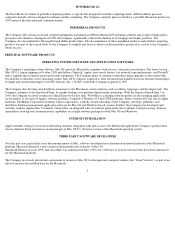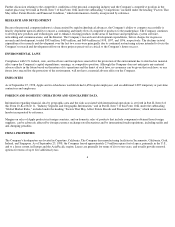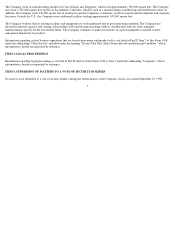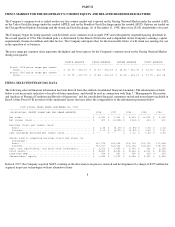Apple 1998 Annual Report Download - page 14
Download and view the complete annual report
Please find page 14 of the 1998 Apple annual report below. You can navigate through the pages in the report by either clicking on the pages listed below, or by using the keyword search tool below to find specific information within the annual report.were also negatively affected by the region's continuing economic problems, declining 34% or $536 million during 1998 compared to 1997.
BACKLOG
In the Company's experience, the actual amount of product backlog at any particular time is not a meaningful indication of its future business
prospects. In particular, backlog often increases in anticipation of or immediately following introduction of new products because of
overordering by dealers anticipating shortages. Backlog often is reduced once dealers and customers believe they can obtain sufficient supply.
Because of the foregoing, backlog should not be considered a reliable indicator of the Company's ability to achieve any particular level of
revenue or financial performance. Further information regarding the Company's backlog may be found below under the subheading "Product
Introductions and Transitions" included under the heading "Factors That May Affect Future Results and Financial Condition."
GROSS MARGIN
Gross margin increased as a percentage of net sales during 1998 to 25% compared to 19% in 1997. This increase is primarily the result of a
shift in revenue mix towards the Company's higher margin Power Macintosh G3 systems and newer PowerBook G3 systems, the low volume
of lower margin consumer products shipped during the first three quarters of 1998, and the declining cost of various components of the
Company's products, particularly those sourced from Asia.
Improvements in the Company's inventory management also contributed to the increase in gross margins. During 1998, the Company
simplified its product line, moving from approximately 15 separate individual products to three main product families. Further, the Company
attempted to use as many industry standard parts in its newer products as possible, expanded the use of supplier hubs at manufacturing sites,
and outsourced the manufacture of printed circuit boards and some systems assembly. These changes have allowed the Company to more
accurately forecast demand, reduce inventory carrying levels and related costs, lessen the financial exposure resulting from inventory
obsolescence and excess inventory levels, and reduce the component cost of obtaining certain standardized parts.
The Company also made changes to its distribution model which has contributed to the increase in gross margins. The Company reduced the
number of locations at which it stages finished goods, generally holding inventory on a regional basis rather than in each country. Also, the
Company reduced the number of its distributors, authorized resellers, and national retail channel partners, particularly in the United States.
These changes have allowed the Company to reduce inventory and related financial exposures, and has reduced the inventory and related
financial exposure associated with inventory held in the Company's distribution channels. The Company has also revised its distribution
channel policies by decreasing the price protection and stock return privileges of its distributors and resellers.
With its reentry into the consumer market, the Company anticipates that lower priced consumer products will comprise a larger portion of net
sales in fiscal 1999. This may negatively impact gross margins. The foregoing statements are forward looking. The Company's actual results
could differ because of several factors, including those set forth in the following paragraph and below in the subsection entitled "Factors That
May Affect Future Results and Financial Condition."
There can be no assurance that targeted consolidated gross margin levels will be achieved or that current margins on existing individual
products will be maintained. In general, gross margins and margins on individual products will remain under significant downward pressure
due to a variety of factors, including continued industry wide global pricing pressures, increased competition, compressed product life cycles,
potential increases in the cost of raw material and outside manufacturing services, and potential changes to the Company's product mix,
including higher unit sales of consumer products with lower average selling prices and lower gross margins. In response to these downward
pressures, the Company expects that it will continue to take pricing actions with respect to its products. Gross margins could also be
12
























